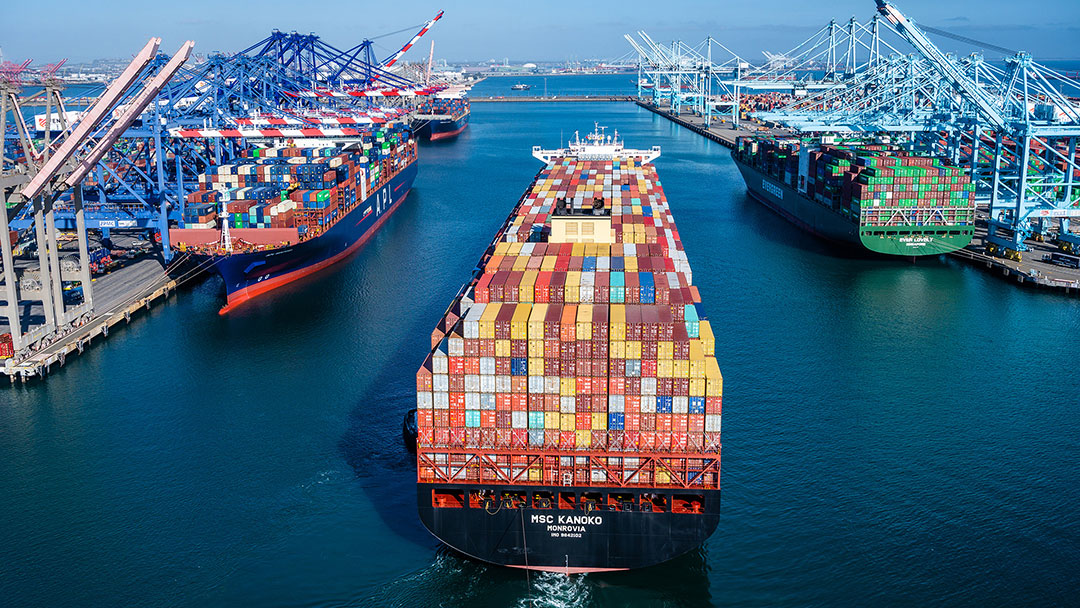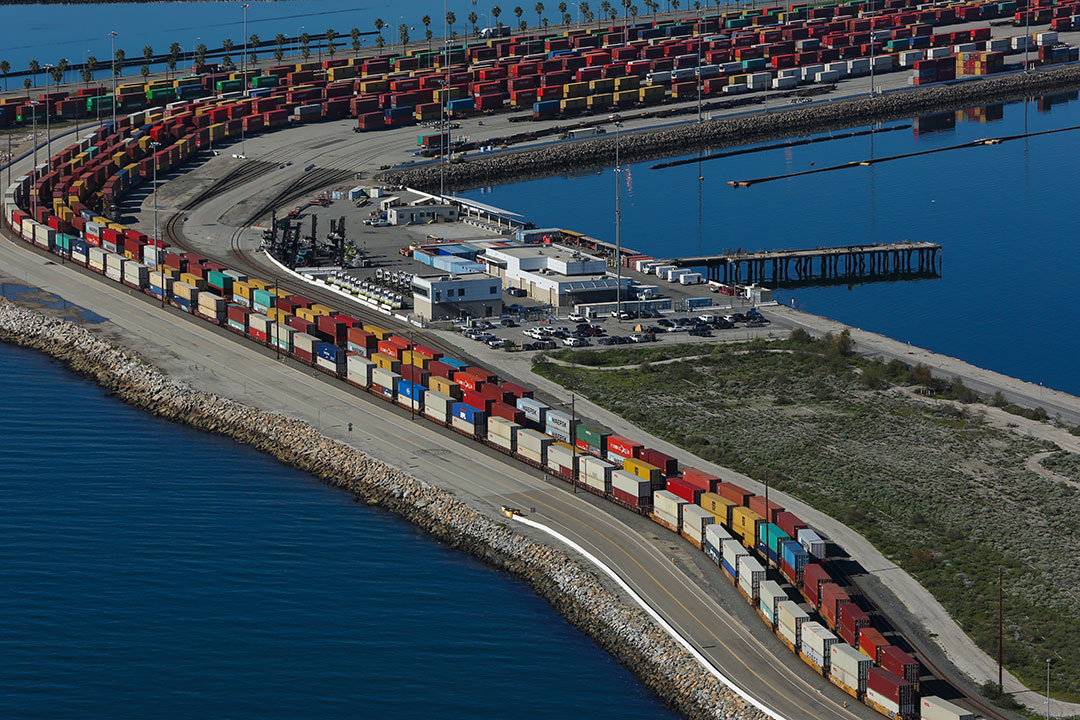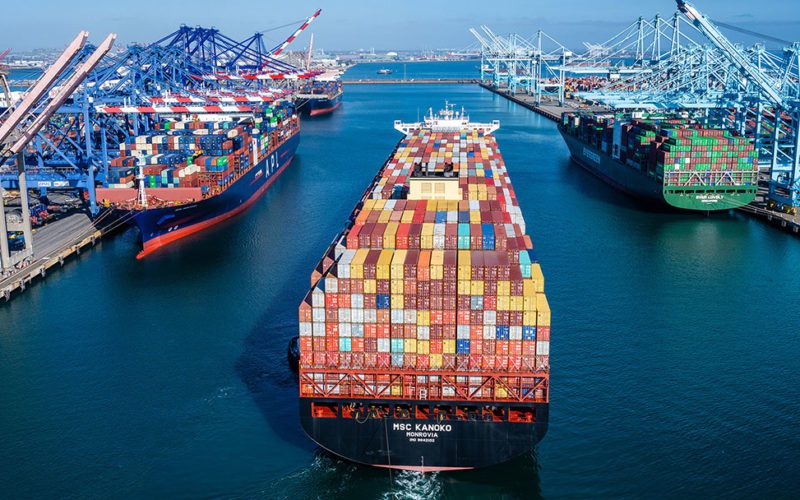
From the hills of San Pedro, Calif., you can see the problem firsthand: Towering cranes unload containerships at every available berth, and stacks of containers swell in the freight yards.
Loaded containerships occupy every available anchorage inside and outside the long seawall. The number of ships waiting to unload in recent weeks at the adjacent ports of Los Angeles and Long Beach has exceeded 50, up from an average of 17.
That view from San Pedro doesn’t show the ships now beyond the anchorage, where ships have been in a controlled drift while unloading takes place in the port. As of mid-October, some 28 loaded ships drifted west of Catalina Island on a course roughly parallel with the coast, waiting for a berth.

Similar crowding is happening in Seattle, New York and Savannah, Ga. Meanwhile, empty containers that could be put in ships and sent back to their origins are sitting in the freight yards.
Although the service and manufacturing sectors reported growth for the 16th consecutive month, transportation bottlenecks have disrupted the supply chain like no other time in modern history. That leaves great disparities in inventory between customers and manufacturers. Prices are increasing and backlogs are growing.
The causes of this disturbance are numerous and distant, but the master culprit lives close to home: consumer demand.
“What you’re seeing is the American consumer’s strength on display every day,” said Gene Seroka, executive director of the Port of Los Angeles. “We are buying more cargo than ever, and we are in the midst of our seasonal products as well as year-end holidays all converging at once.”
A quickly recovering economy combined with government stimulus put more cash into consumers’ bank accounts. They have spent that money on TVs, automobiles, home furnishings, computers and all manner of products that fit into a shipping container.
Covid-19 shut down many other ways of spending money, such as travel, vacations and going out to dinner. The result was a surge in freight traffic from countries that produce these goods.
“A year ago, people started buying stuff because they were hunkered down at home,” said Kip Louttit, executive director of the Marine Exchange of Southern California. “They were remodeling their homes and putting in patio equipment. At the same, time the supply of workers was down because of Covid, so things became slow.”
Increased wait time for goods drove up prices, which in turn brought more traffic as buyers sought lower costs by ordering larger, and earlier, shipments — creating a vicious cycle.
Problems with the supply of raw materials in the manufacturing nations delayed the production of ordered goods, which further slowed delivery times. The temporary shutdown of some terminals in Vietnam and Ningbo, China, did not help matters.
The shortage of truck drivers needed to move goods from ships to freight yards, and from freight yards to warehouses, is another factor. This shortage has been blamed by some on a disinclination to work due to unemployment money. But officials say the situation does not precisely correspond to supply chain disruptions.
“We’ve got a trucker shortage nationwide, with a 20% attrition rate,” Seroka said. “We’ve got to show folks that this is a profession to attract, recruit and retain drivers.”
The results of these interconnected factors are crowds of ships at many of the country’s major ports and packed freight yards containing towers of empty containers. This situation likely will persist into next year and possibly longer.
“Our estimate is certainly into 2022,” said Phillip Sanfield, spokesman for the Port of Los Angeles. “I’ve heard retailers saying their supply inventories are very low, so we expect to see replenishment in supply after the holidays. But we expect a robust import surge to continue at least into the first quarter of 2022.”
Nobody is calling this pace the new normal, but it might start to feel that way the longer the situation continues.
“We have been doing 900,000 TEUs a month,” said Sanfield, referring to twenty-foot equivalent units. “That used to be a strong month during peak season, but now we are averaging that for a year-plus. And that’s all on the import side. Exports are plummeting.”
The Port of Long Beach has already begun round-the-clock operations to unload ships. And, as President Biden announced recently, the adjacent Port of Los Angeles will join it — or try to.
Opinions differ on whether 24-hour operations will ease the bottleneck, as participation in the plan was slow to begin. A pilot program that allowed truckers to pick up cargo between 3 a.m. and 7 a.m. Monday through Thursday attracted no drivers during the first two weeks of its operation.
Cargo is sitting longer than ever before in terminals, and the Port of Los Angeles also began a program to more effectively “push” that freight from the yards by urging the owners to come and get it. About half the products on L.A. docks are sitting five days or longer, and one-quarter of those containers linger 13 days or more.
“Right now, it’s more of a pull system when it comes to cargo on the docks,” Sanfield said. “Importers come and pick up cargo at their discretion, and a lot of cargo has been sitting. So, we are working with cargo owners and trying to get them to commit to come and take it.”
Major retailers like Home Depot, Costco and Walmart, which had begun to charter their own cargo ships, have promised to remove from freight yards the cargo that has slowed freight operations. Expedited trucker licensing in states with large container ports has been floated as a potential solution.
Another possibility advanced by the Pacific Merchant Shipping Association is more precise scheduling of arrival times for ships. This would be accomplished by better communication between ships and marine terminal operators, so ships could slow steam their way to a destination and arrive closer to their scheduled slot
“It used to be that, upon arrival, containerships always went straight to their berth,” said Capt. John Veentjer, executive director of Marine Exchange Puget Sound. “They never even went to anchor until this year, when we started having this backup.” •

